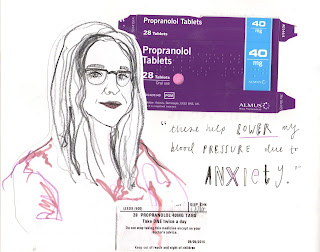The first thing I did this morning was write down a list of suitable (and do-able) options for my practical response, as it is getting a bit silly now that we were meant to decide on Monday and it is now Friday.
Options:
- Come up with names for pills for every day things, such as a pill for boredom, a pill for a bad mood, a pill for being hungry etc. This will emphasise our pill popping culture to solve problems, rather than making the effort to source alternative solutions
- Create adverts that remove stigmas from certain medications in a vintage style which almost recreates sexist/derogatory ads from the 50s/60s
- Illustrate peoples reactions to controversial health ads
- Illustrate peoples perception of medicines that they take
Studio Eureka Moment
This afternoon in the studio I was just observing how many people smoked, and those that are in the process of giving up. Tilly told me that she is trying to give up, and I thought I would ask her about it. She gave some great answers! I jotted these down, and asked also asked Emily about why she smokes.
SYNTHESIS MOMENT: From the packages I have collected, I asked them both what they thought of the off-putting images and new approaches to non-branded cigarette packets. I then took some photos of them rolling their cigarettes and had a go at drawing them in a reportage-y style. (I have been told to do this some more after the Extended Practice crit on Tuesday!)
This quick little exercise has increased my curiosity for individual attitudes, opinions and perceptions towards smoking, and for medication consumed. Smoking is deemed to be a really bad habit for your health nowadays with comparison with the 50's and 60's, where it was marketed as a habit that would actually improve your health, ironically.
It would be interesting to explore this concept further by taking a more interpersonal approach to my topic, which would make sense because it is about self-perception. I am aware that we only have a week left before the Christmas holidays, so I need to be really precise with how I plan the little time I have left in order to produce a practical outcome to the best of my ability.
To do list:
- Illustrate some of the responses to my questionnaire
- Ask people in the studio about their approaches to the medication they take (if they are willing)
- Start to produce roughs for a final outcome










